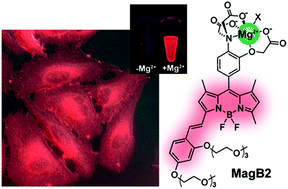Bright, red emitting fluorescent sensor for intracellular imaging of Mg2+ †
Abstract
Fluorescent sensors with low-energy excitation are in great demand for the study of cellular Mg2+ by fluorescence miscroscopy, but to date they remain scarce. Addressing this gap, we report herein a new set of molecular fluorescent sensors for the detection of Mg2+ based on an o-aminophenol-N,N,O-triacetic acid (APTRA) metal-recognition moiety combined with two different BODIPY fluorophores. The new sensors, MagB1 and MagB2, display absorption and emission maxima in the visible range and respond to Mg2+ in aqueous buffer with large fluorescence enhancements. MagB2, a red-emitting fluorescent indicator based on a styryl-BODIPY, displays superior metal selectivity and optical properties compared to its green emitting counterpart, MagB1. With an excellent 58-fold fluorescence turn-on and Mg2+ dissociation constant in tune with physiological concentrations of the cation (low millimolar range), MagB2 enables visualization of changes in intracellular levels of free Mg2+ in live cells with no significant interference from basal levels of Ca2+, the most common competitor.



 Please wait while we load your content...
Please wait while we load your content...